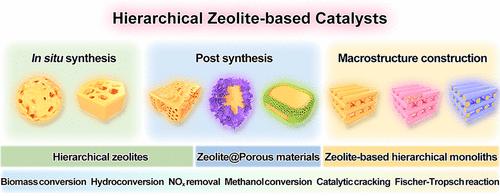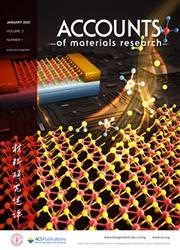Structural Engineering of Hierarchical Zeolite-Based Catalysts
IF 14
Q1 CHEMISTRY, MULTIDISCIPLINARY
引用次数: 0
Abstract
Zeolites are important inorganic crystalline materials with unique microporous structures, intrinsic acidic sites, and high hydrothermal stabilities, which have been widely used in the catalytic field such as methanol conversion, catalytic cracking, and NOx removal. Although the regular channel structures afford zeolite catalysts excellent shape selectivity, the diffusion hindrance caused by the narrow pores (typically less than 2 nm) significantly limits their catalytic activities and lifetimes. Introducing secondary mesopores (2–50 nm) and/or macropores (>50 nm) into the micropore system of zeolites can significantly reduce diffusion limitations and enhance the exposure of more active sites. On the other hand, the delicate integration of microporous zeolites with other functional porous materials into hierarchical heterostructures could offer enhanced or even new catalytic properties that cannot be achieved with single hierarchical zeolite catalysts. For example, tailored meso-/macroporous materials can be combined with zeolites to create composite heterostructures with controllable hierarchical architectures and spatial distributions of functional components from the nano-/microscale to the macroscale in purposeful ways, thus extending their applicability to more intricate and broad heterogeneous catalytic systems. Therefore, the rational design and synthesis of hierarchical zeolite-based materials, spanning from multilevel nanostructures to monoliths, with fascinating catalytic properties hold great significance in the development of efficient energy and environmental catalytic processes.

基于层状沸石的催化剂结构工程
沸石是一种重要的无机晶体材料,具有独特的微孔结构、固有酸性位点和较高的水热稳定性,已被广泛应用于甲醇转化、催化裂化和氮氧化物去除等催化领域。虽然规则的通道结构使沸石催化剂具有优异的形状选择性,但狭窄的孔隙(通常小于 2 nm)造成的扩散阻碍极大地限制了其催化活性和寿命。在沸石的微孔系统中引入二级中孔(2-50 nm)和/或大孔(50 nm)可以显著减少扩散限制,增加活性位点的暴露。另一方面,将微孔沸石与其他功能性多孔材料微妙地集成到分层异质结构中,可以提供单一分层沸石催化剂无法实现的增强甚至新的催化特性。例如,量身定制的中孔/大孔材料可与沸石结合,以有目的的方式创建具有可控分层结构和从纳米/微米尺度到宏观尺度的功能成分空间分布的复合异质结构,从而将其适用性扩展到更复杂、更广泛的异质催化体系。因此,合理设计和合成从多级纳米结构到单体的具有迷人催化特性的分层沸石基材料,对于开发高效的能源和环境催化过程具有重要意义。
本文章由计算机程序翻译,如有差异,请以英文原文为准。
求助全文
约1分钟内获得全文
求助全文

 求助内容:
求助内容: 应助结果提醒方式:
应助结果提醒方式:


